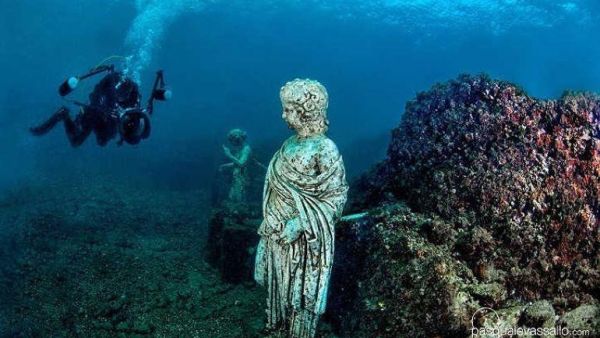Fish dart across mosaic floors and into the ruined villas, where holidaying Romans once drank, plotted and flirted in the party town of Baiae.
Italy, home of the ancient Roman Empire, can show you a new dimension about what it is like to go diving back in time with the Underwater Archaeological Park of Baia near Naples in Southern Italy.
Statues that once decorated luxury abodes in this beachside resort are now playgrounds for crabs off the coast of Italy, where divers can explore ruins of palaces and domed bathhouses built for emperors.
Baia, in the Phlegrean Fields, in the province of Naples, at the time of the ancient Romans became a thriving health and holiday location, near the important commercial port of Portus Julius and the base of the military fleet of Capo Miseno.
Underwater Archaeological Park of Baia ?
— Brindille (@Brindille_) March 1, 2020
?by © Pasquale Vassallo (underwater photographer, b. 1970) pic.twitter.com/x25NFpc22k
Due to the eruption of the Vesuvius Volcano, Pompeii was buried in ashes, and Herculaneum was swallowed by mud. However, it is a different seismic phenomenon that brought Baia underwater: bradyseism. Unlike earthquakes which move mostly horizontally, bradyseism makes the ground move upward or downward.
Baiae was once a popular coastal resort famous for its idyllic location and therapeutic mineral springs. Some described it as a “den of licentiousness and vice" and a "vortex of luxury". Baiae’s hedonism was as notorious as that of Las Vegas today. Seven emperors, including Augustus and Nero, had villas there, as did Julius Caesar and his rival Marc Antoine.
But Baiae wasn’t just a spa retreat. It was a party town, a place for Romans to bathe and banquet, flirt, and frolic. In one of his many elegies to his lover and muse Cynthia, even the poet Sextus Propertius, no great prude, wrote despairingly in 25BC:
“But you must quickly leave degenerate Baiae;
these beaches bring divorce to many,
beaches for long the enemy of decent girls.
A curse on Baiae’s water, love’s disgrace!”
bbc.com/travel
To protect all this, in 2002 the Archaeological Marine Park of Baia was created with an incomparable historical and cultural value. There are 7 underwater sites, ranging from 5 to a maximum of 13 meters of depth.
The submerged park of Baia, which extends along the coast of Bacoli and Pozzuoli?#art #Archaeology pic.twitter.com/4QvlJTLMJM
— Roxy ♡ (@LunahNera) August 2, 2020
There are paved roads flanked with buildings, magnificent villas owned by the elite Roman families, dozens of marble statues, and bath complexes. Most of the buildings have collapsed walls but the different rooms are discernable.
VIDEO: The town of Baiae was once a spot for holidaying Romans to drink and party - until it began to sink.
— AFP News Agency (@AFP) August 21, 2021
Now the ruins of the palaces and domed bathhouses built for Rome's nobility form an underwater archaeological park near Naples pic.twitter.com/eKu012Wlt3
Visitors can view the crumbled structures and amazingly preserved statuary of the city through glass-bottomed boats, snorkeling, or even scuba dives which allow people to actually swim amongst the copious ruins. While the city is no longer a resort, its waters still hold wonders.







